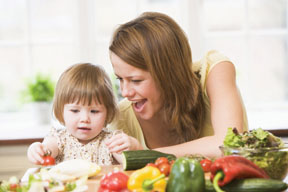| << Back |
Family Ties: Kids in the Kitchen – Family-Friendly Cooking Activities
By Michelle Vessel
If echoing cries of “Mom, I’m hungry!” and “Mom, I’m bored!” are pretty much non-stop occurrences around your household, it may be time to introduce your kids to a hobby that can solve both of these problems in one fell swoop: the wonderful world of cooking. From barely-walking toddlers to teens on the verge of setting off on their own, there’s plenty of fun – and practical value – to be gained from spending time in the kitchen with your kids.
A Recipe for Success
According to Jennifer Low, author of Kitchen for Kids: 100 Amazing Recipes Your Children Can Really Make, cooking and baking call on a broad spectrum of skills and talents that will serve kids well throughout their entire lives. In addition to boosting their practical know-how and instilling a sense of how to find their way around a kitchen, cooking activities can help kids cultivate healthy eating habits and teach basic facts about nutrition. What’s more, registered dietician Susan Moores, a spokesperson for the American Dietetic Association, says that even the pickiest eaters are more likely to sample new foods if they had a hand in the meal preparation process.
Age-Appropriate Fun in the Kitchen
No matter what age group your child falls into, there’s bound to be something they can do in the kitchen. The trick lies in doling out age-appropriate tasks that are challenging and engaging without being overly complex or potentially dangerous.
Toddlers – For the littlest helpers, imitative kitchen play may be the best place to start. Set up their play kitchen while you make dinner, or give them a few safe pots, pans and utensils to play with. Once kids are old enough to follow simple instructions, have them rinse vegetables, carry discarded items to the trash can, stir foods that aren’t currently cooking and add sprinkles to baked goods.
Preschoolers (3-5) – Kids in this age group are often very enthusiastic kitchen helpers. Keep tasks relatively short and break up activities into distinct chunks, allowing them to assist by stirring foods, retrieving specific ingredients or (non-sharp) tools, adding pre-measured ingredients or tearing vegetables like spinach or lettuce. Older preschoolers with advanced motor skills may be ready to measure liquid or dry ingredients and crack eggs.
Primary grades (6-9) – This phase of childhood usually represents the height of pickiness and food selectivity, so give your child every opportunity to branch out by assembling and measuring ingredients, reading recipes, or stirring foods that are simmering over low heat in a sauté pan (under adult supervision, of course!). Pre-made components are a great way to encourage independent cooking skills, so stock up on things like pre-cooked pizza shells, frozen waffles, or steam-in-the-bag vegetables that can be used as a base for complete meals.
Tweens & Teens (10 & up) – Kids in this age group are usually ready to take on basic recipes with moderate supervision. Straightforward tasks like baking cookies from scratch, whipping up a batch of pancakes or French toast, or preparing a simple pasta dinner should be well within their abilities, especially with a bit of adult help and encouragement. As teens get older, many are ready to take on even the most challenging of cooking tasks. However, don’t assume too much; they may have difficulty winging certain skills without input from a knowledgeable adult. Within reason, feel free to give your teen free reign in the kitchen, reinforcing safety guidelines and setting clear expectations about after-meal cleanup. Begin introducing them to other aspects of food preparation, such as meal planning, budgeting and grocery shopping.
Take it to the Next Level
Now that you’ve introduced your kids to some basic cooking techniques, it’s time to branch out. Here are some project and activity ideas to entertain and educate the budding chef in your family.
Plant a kitchen garden – Take cooking a step further by growing your own ingredients. Opt for a large plot garden or stick with a few containers on your back porch, growing kid-friendly favorites like strawberries, watermelon, and pumpkin. Sneak in a few veggies for extra credit.
Cook up a science project – Measuring, mixing, blending – many of the basic techniques that you use when following your favorite recipe – can also be applied to science activities. Check the “recipes” listed on the website bizarrelabs.com for ideas and inspiration.
Plan a cuisine-themed party – If your pint-sized chef has some likeminded friends, consider hosting a cooking party. Assemble a make-your-own-pizza station, and then have the kids bake and decorate cupcakes for dessert. Spice things up with a Top Chef-style contest scaled back to match your child’s skill level.
Spend time with an expert – If your child shows a real flair for cooking, it may be worth it to invest in a cooking class. National chains like Whole Foods and Sur la Table often offer kids’ cooking classes; check with retailers in your neighborhood for specific details.
Cook by the book – Need some inspiration? Check out classic kids’ cookbooks from luminaries like Rachel Ray, Paula Deen, Emeril Lagasse, Martha Stewart and Williams-Sonoma.
Teaching your favorite foodies-in-training how to wield a spatula and crack an egg is just one part of spending time together in the kitchen. With a repertoire of basic techniques at their disposal and a little imagination, there’s no limit on the fun you can have with your kids in the kitchen, whether they’re toddlers, teens or somewhere in between.








